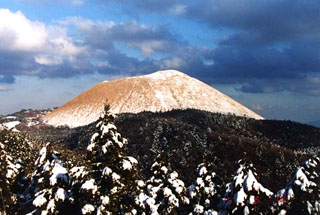Report on Izu-Tobu (Japan) — October 1995
Bulletin of the Global Volcanism Network, vol. 20, no. 10 (October 1995)
Managing Editor: Richard Wunderman.
Izu-Tobu (Japan) Tremor observed again
Please cite this report as:
Global Volcanism Program, 1995. Report on Izu-Tobu (Japan) (Wunderman, R., ed.). Bulletin of the Global Volcanism Network, 20:10. Smithsonian Institution. https://doi.org/10.5479/si.GVP.BGVN199510-283010
Izu-Tobu
Japan
34.9°N, 139.098°E; summit elev. 1406 m
All times are local (unless otherwise noted)
Mid- and late-September micro-earthquake swarms occurred offshore near Capes Kawana-zaki and Shiofuki-zaki (BGVN 20:09), an area adjacent Ito City on the E coast of the Izu Peninsula. In late September and early October pulses of seismicity continued off these Capes, trailing off toward mid-October (figure 16). Located ~5 km SW of the epicenters, Kamala Seismic Station recorded 5,881 October earthquakes. The largest earthquake struck at 1142 on 1 October with M 4.8; nearby Into City sustained a JMA-scale intensity of IV. Small-amplitude tremors occurred on both 4 October (four times), and 12 October (one time); low-frequency earthquakes took place on 4 October (four times) and 6 October (one time). Volumetric strain at Higashi-Izu and Ajiro acted in the sense of compression.
 |
Figure 16. Hourly earthquakes at Izu-Tobu recorded ~5 km SW of the seismic sources, September-October 1995. Courtesy of JMA. |
Geological Summary. The Izu-Tobu volcano group (Higashi-Izu volcano group) is scattered over a broad, plateau-like area of more than 400 km2 on the E side of the Izu Peninsula. Construction of several stratovolcanoes continued throughout much of the Pleistocene and overlapped with growth of smaller monogenetic volcanoes beginning about 300,000 years ago. About 70 subaerial monogenetic volcanoes formed during the last 140,000 years, and chemically similar submarine cones are located offshore. These volcanoes are located on a basement of late-Tertiary volcanic rocks and related sediments and on the flanks of three Quaternary stratovolcanoes: Amagi, Tenshi, and Usami. Some eruptive vents are controlled by fissure systems trending NW-SE or NE-SW. Thirteen eruptive episodes have been documented during the past 32,000 years. Kawagodaira maar produced pyroclastic flows during the largest Holocene eruption about 3,000 years ago. The latest eruption occurred in 1989, when a small submarine crater was formed NE of Ito City.
Information Contacts: Volcanological Division, Seismological and Volcanological Department, Japan Meteorological Agency (JMA), 1-3-4 Ote-machi, Chiyoda-ku, Tokyo 100 Japan.

